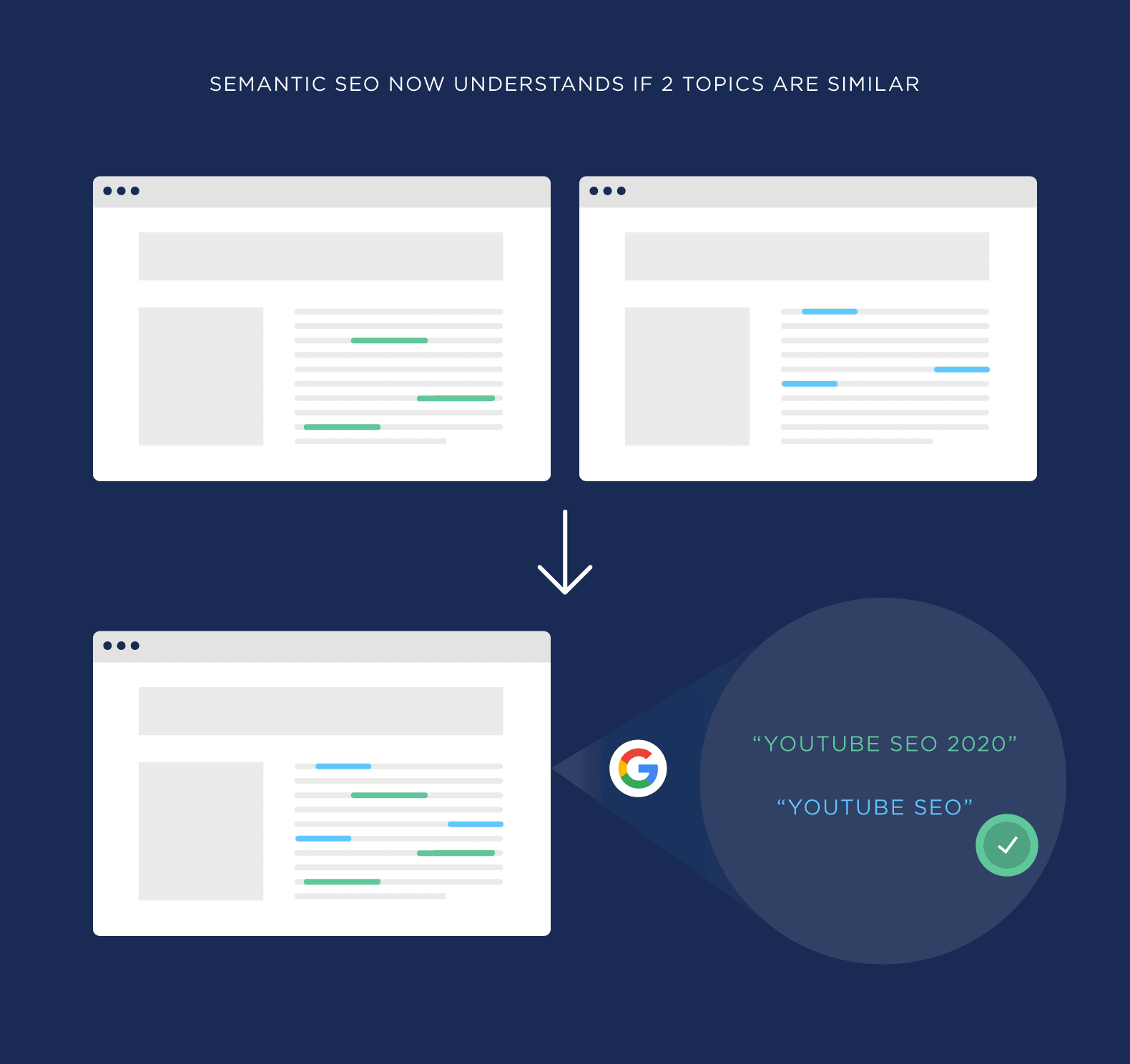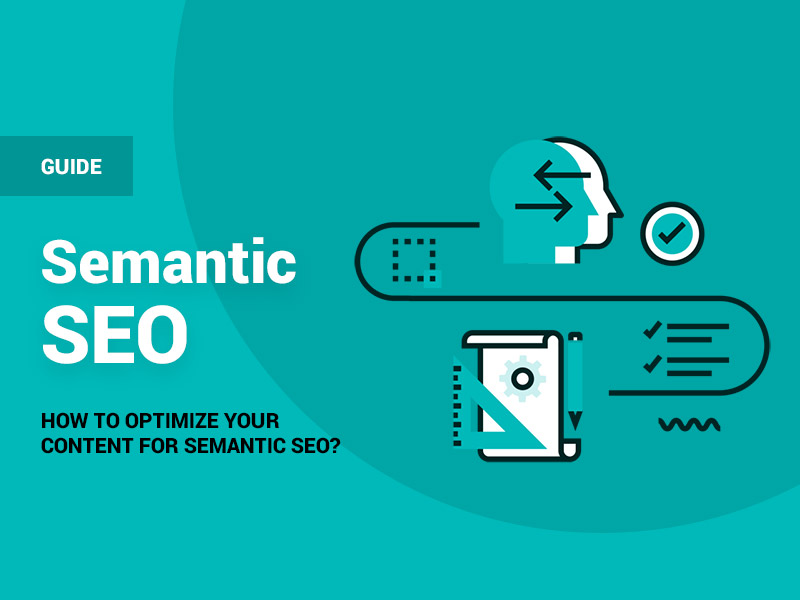Hello!
 Google’s growth over the past 20 years is amazing when you consider it. Users used to be impartial towards the likes of Bing, Yahoo, and Ask Jeeves not long ago. These names are now extinct while Google can provide relevant answers quickly, even when we enter incoherent phrases or have typos. Google understands us. It keeps improving.
Google’s growth over the past 20 years is amazing when you consider it. Users used to be impartial towards the likes of Bing, Yahoo, and Ask Jeeves not long ago. These names are now extinct while Google can provide relevant answers quickly, even when we enter incoherent phrases or have typos. Google understands us. It keeps improving.
The ever-evolving game of SEO has been largely dependent on the smarts of the Google Algorithm, and it’s changed a lot over the years. What is the latest development? Semantic SEO. But what exactly is semantic SEO? And how do you optimize your content in a way that keeps the Google robots happy? Let’s take a closer view.
Where did semantic SEO come from?
It helps to know a little bit about Google’s history to help you understand how to optimize your Google search results.
SEO was initially based on single keyword-focused algorithms. From 2012 to 2022, SEO relied on single keyword-focused algorithms. Then, there were some significant catalytic leaps: ‘Knowledge Graph’, ‘Hummingbird’, ‘RankBrain’, and ‘BERT.
 Knowledge Graph created a mindmap that Google could use to find the links between words. Hummingbird enabled Google to see the full meaning of a search query, not just a list of keywords. Hummingbird was also able to interpret the overall topic of a webpage, which is why keyword stuffing, a black-hat SEO technique, has fallen out of favor.
Knowledge Graph created a mindmap that Google could use to find the links between words. Hummingbird enabled Google to see the full meaning of a search query, not just a list of keywords. Hummingbird was also able to interpret the overall topic of a webpage, which is why keyword stuffing, a black-hat SEO technique, has fallen out of favor.
With a priority in understanding users’ search intent better, the context of these search terms is also judged against existing search histories, considering their relevance within local and global parameters. It added context.
For example, let’s say you typed corona into Google’s search bar. Google predicts that you are more interested in the COVID-19 situation in your city than the beer. The first results you will see will relate to that. Semantic SEO is a major step in the world of Google contextualizing.
What is semantic SEO?
It’s useful to understand semantic SEO.
According to the Oxford English Dictionary semantics refers to “the branch of logic and linguistics concerned with meaning.” These two areas include logical semantics which deals with matters like sense and reference, presupposition, and implication, and lexical semantics which deals with the analysis and relationships between
Semantic SEO is based upon lexical semantics, which describes how words relate to each other.
1. How to optimize your content for semantic SEO
 Google’s goal is to answer users’ questions by providing the most relevant information and answering any follow-up questions. Google knows that humans are curious creatures. We will show you how to optimize content for quality and be picked up by Google.
Google’s goal is to answer users’ questions by providing the most relevant information and answering any follow-up questions. Google knows that humans are curious creatures. We will show you how to optimize content for quality and be picked up by Google.
You must first understand your article’s intent. In other words, what reader’s needs do you address? There are three types of intent. It is important to understand which one your piece falls under if you want to keep readers happy. The internet is used by users to search for either.
- Learn something
- Buy something, or
- You can find something you are looking for (e.g., the shop that a friend recommended).
This intent can be broken down into roughly 80%, 10%, and 10%. Users are searching the internet for answers to specific questions. It is important to know the questions that your article is answering. If you don’t, your website will not convert and your bounce rate will skyrocket. Google will also penalize your site for not answering what your readers need.
2. Create quality content (not pieces jammed with keywords)
 Most people don’t use Google to search for digital encyclopedias and browse through the information. They need the details. The worst thing you can do is give a superficial overview. This is exactly why Wikipedia and Google Knowledge Panels exist.
Most people don’t use Google to search for digital encyclopedias and browse through the information. They need the details. The worst thing you can do is give a superficial overview. This is exactly why Wikipedia and Google Knowledge Panels exist.
Knowledge panels are short snippets of general information that are displayed at the top of search results. Your general information article is really getting in the Google ring, and you can guess where we’d place our wagers.
After you’ve identified the question, take the time to explain the value. Make sure your article is complete. You could even answer other questions about that path of curiosity.
Top tip: Recent data shows that with web design statistics you can still use content that you wrote years ago to increase your SEO and organic Google traffic. Google bots crawl every page on your website to identify search terms that are relevant to them. Having a blog active increases the likelihood of multiple pages being found and displayed on Google’s first page.
Your piece should contain long-tail keywords that are related to your topic. Google will assess the quality and quantity of semantically related phrases in your article to increase your article’s relevance score.
A quick example…
 Imagine that you are writing an analysis piece on Harry Potter. You could use the following semantically related phrases: ‘The Boy Who Lived next Door’, ‘The Seventh Harry Potter Book,’ and ‘Harry Potter.’
Imagine that you are writing an analysis piece on Harry Potter. You could use the following semantically related phrases: ‘The Boy Who Lived next Door’, ‘The Seventh Harry Potter Book,’ and ‘Harry Potter.’
Google would crawl the article to determine if it was suitable for readers looking to understand the relationship between Longbottom and Potter. However, semantically related phrases about an entertainment piece could include ‘child actors’, ‘cast of Harry Potter’, and ‘film trip.
Ten years ago, SEO strategies for both articles were to use the keyword “Harry Potter”, as many times as possible. Thankfully, Google’s comprehension skills have improved, so we can focus more on writing richer pieces of content, without repeating ourselves unnecessarily.
Also read: CRM
3. Long-form content is better than short
It’s difficult to explain a topic in 300 words. Don’t let people waste your precious time with cat-got-your tongue.
 Google doesn’t want users to have to navigate through multiple pages to find the answers. That would be similar to calling customer service and being redirected to a different department for each question. It’s frustrating!
Google doesn’t want users to have to navigate through multiple pages to find the answers. That would be similar to calling customer service and being redirected to a different department for each question. It’s frustrating!
There is no time limit on your stage time, so be generous. Instead, try writing pieces between 2,000 and 2,500 words to cover more ground and provide a greater safety net when answering many questions.
Longer articles can help increase your lead conversion rate and drive organic traffic. You also have more options to include semantically linked phrases, which is a great thing when optimizing your site to semantic SEO.
4. Increase the relevance of your article by reverse-fitting it to Google
Take a look at the results of the Google dropdown search. This will help you find semantically related phrases that you can use in your article. This will also help you to understand your user’s interests.
Google’s dropdown lists will help you to understand the interests of your users.
 Additionally, you can scroll down to the end of the search results page, and record the small list of ‘Related Keywords’ displayed here.
Additionally, you can scroll down to the end of the search results page, and record the small list of ‘Related Keywords’ displayed here.
These can help you to plan what you will cover in your article. They also give you a list of LSI keywords (aka long tail keywords) and the types of medium-tail keywords that you can use. It is better to include more of each. This will allow you to reach a wider audience with your article, as Google will automatically add you for longer-tail keywords.
5. Rank well for informational queries to earn a ‘Featured Snippet’
The Position 1 spot in a Google search result page was once coveted by everyone. People now want to be in Position 0. Why? Google also shows a small portion of your content, so you are not only the first. It’s like having a foot in the door of attention. This increases traffic to your site from users who want to read more.
 These ‘featured snippets can be targeted by structuring your content using question headlines followed by bullet points answers or scannable material. Using multiple headlines that include popular questions and answers to your topic will increase your chances of ranking higher in the search results. Instead of focusing on one keyword to attract people, try finding people who are interested in different topics.
These ‘featured snippets can be targeted by structuring your content using question headlines followed by bullet points answers or scannable material. Using multiple headlines that include popular questions and answers to your topic will increase your chances of ranking higher in the search results. Instead of focusing on one keyword to attract people, try finding people who are interested in different topics.
Don’t worry if you don’t win the Position 0 spot. You can still aim for a highly-placed position. Google displays an accordion-style FAQ with follow-up questions under the ‘featured search snippet’. This is a highly respectable prize and a worthy runner-up.
6. Use structured markup and semantic tags in your code
This backend advanced SEO technique is invisible to users and helps Google understand the structure of your article. The use of semantic HTML elements improves searchability and accessibility. You will also have a better chance of achieving the Google 0 position.
 Semantic tags give the browser more information about the meaning and hierarchy of the content. Instead of just seeing
Semantic tags give the browser more information about the meaning and hierarchy of the content. Instead of just seeing
AndUse semantic tags to distinguish blocks of content.
To organize your content. Use element heading tags within content blocks (h1,h2,h3,h4,h5, and paragraph). These tags break up your text and place it in order of importance.
Also read:
- Know the Tips, How Coffee helps in Weight Loss?
- Top 6 Ways to Increase Podcast Listeners
- How Businesses Can Make the Most of Beachhead Strategy
Final thoughts
There’s an opportunity to delve deeper into topics to rank well as a specialist article covering a niche topic. You can also feature it as an informational snippet in Position 0. Now Google has caught up in leaps and bounds; you can worry less about gaming the system with keyword-stuffing — and instead, challenge yourself to write even more meaningful content.
Thank you!
Subscribe to our newsletter! Join us on social networks!
See you!






